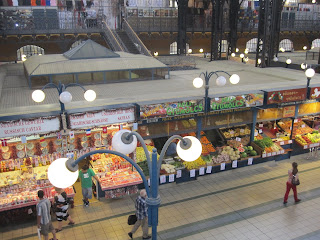Arriving in Budapest recently, my new and lovely wife Daiga and I found ourselves in the city’s central market, an impressive two-storey building that’s seen its share of ups and downs but which can be supplied through thick and thin by tunnels from the adjacent Danube.
Built in 1896, it’s survived the end of the Austro-Hungarian empire, two wars and fifty years of Communism and has recently been refurbished and – as you can see here – is looking great. We allowed the sights and scents of Hungary to wash over us: excellent Tokai wine, the ubiquitous green pepper, the schnapps, caviar, Bull's Blood… the fancy linen, Ferencvaros football shirts and novelty key rings jostling for our attention.
But what really caught my eye - oddly enough, as I waited by the public toilets at the back of the market hall - was a display of specialist mushrooms, ranked according to their toxicity but offering a splendid opportunity to ponder that fine line between life and death a stroll in a Hungarian forest one afternoon might offer.
For example: these mushrooms (right). Would you eat them? (yes/no)
They’re brightly coloured, a particularly healthy shade of red, but that’s usually nature’s way of saying “Danger.” So: Yes or no?
As I remember they are perfectly edible, yet when I showed this picture to Daiga she thought they were the highly poisonous red variety.
Who would you trust: a dangerously ill-educated Englishman who’s only ever been into a forest on a mushroom-picking trip before in search of examples of the psilocybin variety, usually buying them for his lunch from the local greengrocer, or a mushroom-hardened savvy country girl for whom making delicious mushroom sauce to go with country spuds for lunch is almost a motor reaction on a daily basis? I know where my vote goes, and I'm the dangerously ill-educated Englishman reading a sign that says they're safe.
Mushroom pickers, beware. Health and safety is the prime concern. Mushrooms can kill. Check your mushrooms at http://www.rogersmushrooms.com and if in doubt, don’t.
 |
| Laccaria amethystina |
This is Laccaria amethystina, also known as the Amethyst Deceiver. It’s found in North America and Europe, is edible and grows in woods or on the ground. That violet colour’s a bit off-putting though, isn’t it? And I'm not sure what the deception might be either. Perhaps that they might kill you slowly and in agony if you ate them?
 | |
| The Common Stinkhorn |
Now for exhibit 4, a cheeky little item.
Phallus impudicus means .. well, I’ll leave you to look that up - but it involves ‘standing proud’. This mushroom also goes by the name of ‘the common stinkhorn’ appearing in forests and well-mulched gardens in late summer and autumn. It has a slimy olive-green head containing spores which are transported by insects attracted by its smell .. of rotting dead animals.
Despite the stink it’s not poisonous and it’s often eaten raw, pickled or in sausages in parts of France and Germany. Do they know that flies stamp around in the sticky secretions on the head and then defecate spores somewhere else?
I have to thank Wikipaedia for this next gem (and the quote): apparently the aunt of Charles Darwin’s granddaughter Gwen Raverat (Aunt Etty) used to hunt for stinkhorns in the Cambridge woods where she grew up:
“In our native woods there grows a kind of toadstool, called in the vernacular The Stinkhorn, though in Latin it bears a grosser name. The name is justified, for the fungus can be hunted by the scent alone; and this was Aunt Etty's great invention. Armed with a basket and a pointed stick, and wearing special hunting cloak and gloves, she would sniff her way round the wood, pausing here and there, her nostrils twitching, when she caught a whiff of her prey; then at last, with a deadly pounce, she would fall upon her victim, and poke his putrid carcass into her basket. At the end of the day's sport, the catch was brought back and burnt in the deepest secrecy on the drawing-room fire, with the door locked; because of the morals of the maids.”
So there you are: the secret world of the mushroom, and of the mushroom admirer. And if we hadn't stopped to use the loo at the market, we would have been none the wiser.


No comments:
Post a Comment